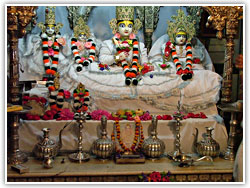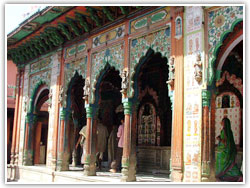|
|
Ayodhya Attractions
.............................................................................................................................................................................. |
|
Tourist
Attractions in Ayodhya
The famous places in Ayodhya are Shri Ramjanma Bhoomi,
Ramkote, Kanak Bhavan, Swargdwar, Nageshwarnath Temple,
Hanumangarhi, Treta Ke Thakur, Tulsi Smarak Bhawan and
Ramkatha Museum. The Guptar Ghat, Raj Ghat, Ram Ghat,
Lakshman Ghat, Janki Ghat, Naya Ghat, Dantdhavan Kund,
Vidya Kund are the main ghats in Ayodhya. There are also
several Jain temples at Ayodhya. |
| |
|
Ramkote
The Ramkote is the main place of worship in
Ayodhya. The ancient citadel of Ramkote stands on
an elevated ground in the western part of the
city. Presently, the area is occupied by
buildings, mostly temples and maths. This place is
visited by pilgrims throughout the year, but
mainly during the Ram Navami, the birth of Lord
Rama.
Shri Ramjanma Bhoomi
Shri Ramjanma Bhoomi is believed to be
|
 |
|
|
discovered by King Vikramaditya. It is the birth place
of Lord Rama. On the auspicious day of Ram Navami, the
devotees come here in large numbers.
Swargdwar
The strip of land from Sahastradhara to Nageshwarnath
temple is commonly known as Swargdwar. The buildings on
the Ghat facing the river were mainly built during the
reign of Nawab Safa Jung and his Hindu minister Naval
Rai, who is credited in particular for their
construction. The buildings and the ghats offer a fine
view. In recent years, the river bed has shifted
northwards, leaving the Ghats, therefore the new Ghats
were built around 1960 along the new bridge. It is
popularly known as ‘pairi’ and offers an excellent view
from the bridge.
Nageshwarnath Temple
Nageshwarnath is considered to be the presiding deity of
Ayodhya. The temple of Nageshwarnath is said to have
been established by Kush, the son of Lord Rama.
According to the legend, the Kush lost his armlet while
bathing in the river Saryu, which was picked up by a
Nag-Kanya, who fell in love with him. As she was devotee
of Lord Shiva, Kush erected this temple for her. It is
said that this has been the only temple to have survived
till the time of king Vidramaditya. It was only through
this temple that king Vikramaditya was able to locate
Ayodhya and the different shrines here. The present
temple was built during the reign of Safdar Jung by
Naval Rai in 1750. The festival of Shivratri is
celebrated here with great enthusiasm.
Tulsi Smarak Bhawan
Tulsi Smarak Bhawan was built in the memory of Goswami
Tulsidas and is used for prayer meetings and religious
discourses. It also houses the ‘Ayodhya Shodh Sansthan’,
where a large collection of literary works on Swami
Tulsidas can be seen.
Ramkatha Museum
The Ramkatha museum was established in Ayodhya since
1988. This museum is engaged in collection, preservation
and conservation of antiquities related to the story of
Lord Rama.
Kanak Bhavan
Kanak Bhawan is one of the finest temples in Ayodhya. It
was built by queen of Tikamgarh, Vrishbhanu Kuvari in
1891. The main temple is built around an open inner
court in which stands a small shrine of Rampada. The
main idols installed inside the garbhagriha are of Sita
and Lord Rama. The sanctum is well decorated. |
|
|
|
Hanumangarhi
Hanumangarhi is one of the most important temples
of Ayodhya. This temple is situated in the center
of the town and approachable by a flight of 76
steps. As per the legends, the Lord Hanuman lived
here in a cave and guarded the Ramkote. The
present temple was built in the middle of 10th
century, in the shape of a four sided fort with
circular bastions at each corner. The temple
houses an image of Lord Hanuman.
|
 |
|
|
Treta Ke Thakur
The Treta Ke Thakur is a temple that stands at the place
where Lord Rama is said to have performed the Ashvamedha
Yajna. About 300 years ago the Raja of Kulu built a new
temple here, which was improved by Ahaylabai Holkar of
Indore and the adjoining Ghats were also built at that
time. The initial idols in black sandstone were
recovered from river Saryu and placed in the new temple,
known as the Kale Ram Ka Mandir.
Excursion
from Ayodhya
Gorakhpur
Gorakhpur is the last major town of India on the
Indo-Nepal border and provides easy access to some of
the most important places connected with the life of
Lord Buddha. The British and the Gurkha armies clashed
in the region around the town in the early 18th century.
Later it became the recruitment centre for Gurkha
soldiers enlisting into the British and Indian armies.
It is a delightful centre and a major railway
maintenance town. It is also a pilgrimage centre for
certain Hindu sannyasis and for the Gorakhnath Temple.
Kushinagar
Kushinagar or Kushinara of Yore is the place where the
Lord Buddha died, at the age of 80 and was cremated and
achieved the state of Parinirvana. Kushinagar is
situated about 55 kms. away from Gorakhpur and a revered
place for Buddhist pilgrims. In ancient times,
Kushinagar was known as Kushinara and was a small town
of not great significance in the Malla kingdom. The main
tourist attraction in Kushinagar is the Mahaparinirvana
temple, containing the reclining statue of Lord Buddha.
More.... |
|